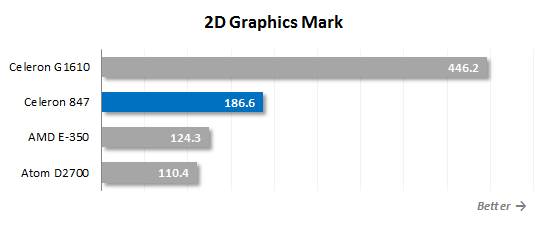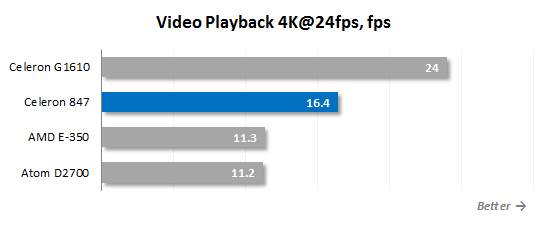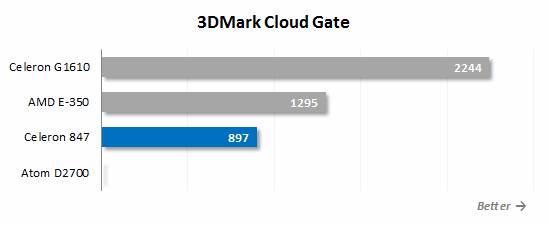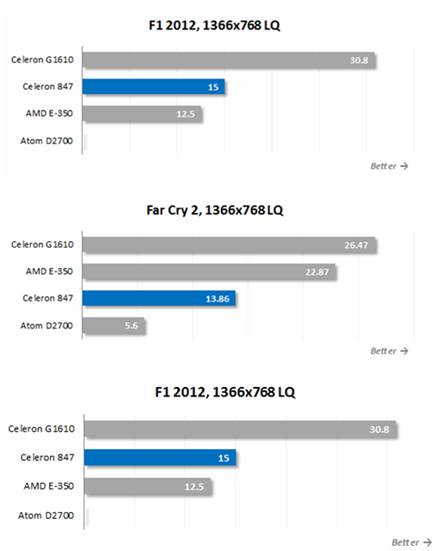Graphics performance
We do not usually test 2D graphics
performance in our review, but the Cedarview-based
Atoms made us change our custom because their integrated graphics core GMA 3650
was criticized for being too slow at rendering the OS interface. Driver
updates have improved this situation, so opening, closing and moving
application windows is fast enough now, but we want to express this in numbers
using PassMark Performance Test 8.0 which has a handy 2D graphics benchmark.

2D
graphics performance
Actually, the GMA 3650 core from Atom D2700
has the slowest speed but AMD E-350 is not too far ahead. Celeron 847 is ahead
of both, but the modern Ivy Bridge Celerons make the OS interface even more
responsive. One thing should be particularly noted: Atom D2700 is the only CPU
in review that is not compatible with Windows 7's Aero interface. Although you
can enable the latter, the rendering speed plummets down, so it becomes
impossible to work even with the simplest applications.
HD video playback is important for HTPCs
which run on mini-ITX platforms with economical processors, so we want to check
out this usage scenario, too.
Atom (Cedarview) processor, E-series
(Bobcat) and Celeron (Sandy Bridge) all have hardware engines for accelerated
decoding of HD video in popular formats. That’s why every tested platform
ensures smooth playback of 1080p video without dropped frames. There is only
one exception. Atom D2700 can easily play video in H.264 and MPEG2 formats but
has problem with VC-1, dropping frame. AMD E-350 and Celeron 847 do not have
such errors. We examined their Radeon HD 6310 and HD Graphics cores before and
we found that they had the ability to decode HD video, even in the 1080p/60fps
format, without any errors.
However, as higher resolutions and bitrates
get more popular, inexpensive processors may find it difficult to cope.
Therefore, we use in our next test a widescreen 4096x2048p@24fps clip encoded
in H.264 format with a bitrate of about 22 Mbps. Playing via DXVA with enabled
hardware decoding, we had dropped frames. And the number of dropped frames
depends directly on the capabilities of the CPU. The diagram below shows the
average number of displayed frames (up to a maximum of 24 fps) when test video
is reproduced in the Media Player Classic player - Home Cinema version 1.6.6
with K-Lite Codec Pack 0.9.8 and the video encoding (including UHD) is enabled
through the LAV Filters.

The
average number of displayed frames
As you can see in the diagram, not any
economical processor can decode 4K video as well as Celeron G1610 does. We
always have a few missing frames: more on the Intel Atom D2700 and AMD E-350
and less on the Celeron 847 (about 30% of the total), but there are dropped
frames anyway. In other words, it is impossible to build an intolerance
multimedia player out of an inexpensive energy-efficient platform. You need
heavier weapons for that. On the other hand, if you're not ready for UHD
formats but prefer normal Full-HD resolution, AMD E-350 and Celeron 847 can be
proposed for a compact and economical HTPC.
For 3D performance, the platform that we
are discussing in this review can hardly be suggested that even for gaming
systems for new users. 3D performance is so low, so you can only run games
with low system requirements. By the way, there are fundamental differences
between the integrated graphics cores. The radeon HD 6310 core in the AMD
E-350 is the most advanced variant in terms of specifications. It is the only
which support DirectX 11. Celeron 847's Intel HD Graphics only supports DirectX
10 (while HD Graphics core of Intel's LGA1155 Celeron processors fully supports
DirectX 11). Atom can only be compatible with DirectX 9.
Actual performance is illustrated by the
results of the DirectX 3DMark Cloud Gate benchmark.

Intel
Celeron 847 is slower than AMD E-350
Atom D2700 can not pass this test for some
reason while the Intel Celeron 847 is slower than AMD E-350 as expected. HD
Graphics from Celeron 847 is the fastest integrated graphics core among those
economical processors but it is only half as fast as its own new version.
Low performance of the integrated graphics
core is not the only reason why inexpensive economical platforms can’t be used
for gaming computers. They often lack sheer computing speed. We can illustrate
this fact by running a few games which don’t have high system requirements.
Note that we run at low resolution (1366x768 pixels) and at the lowest visual
quality settings.

Frame
rate is often limited by CPU
Even with such comfortable settings we
can’t make our economical platform deliver good performance. As expected, the
frame rate is often limited by the CPU, which is true for the E-350 at least,
especially in Starcraft 2 and F1 2012. The celeron 847 overcomes
the AMD processor in these games although the latter's Radeon HD 6310 should
not be worse than the first generation of Intel HD Graphics.